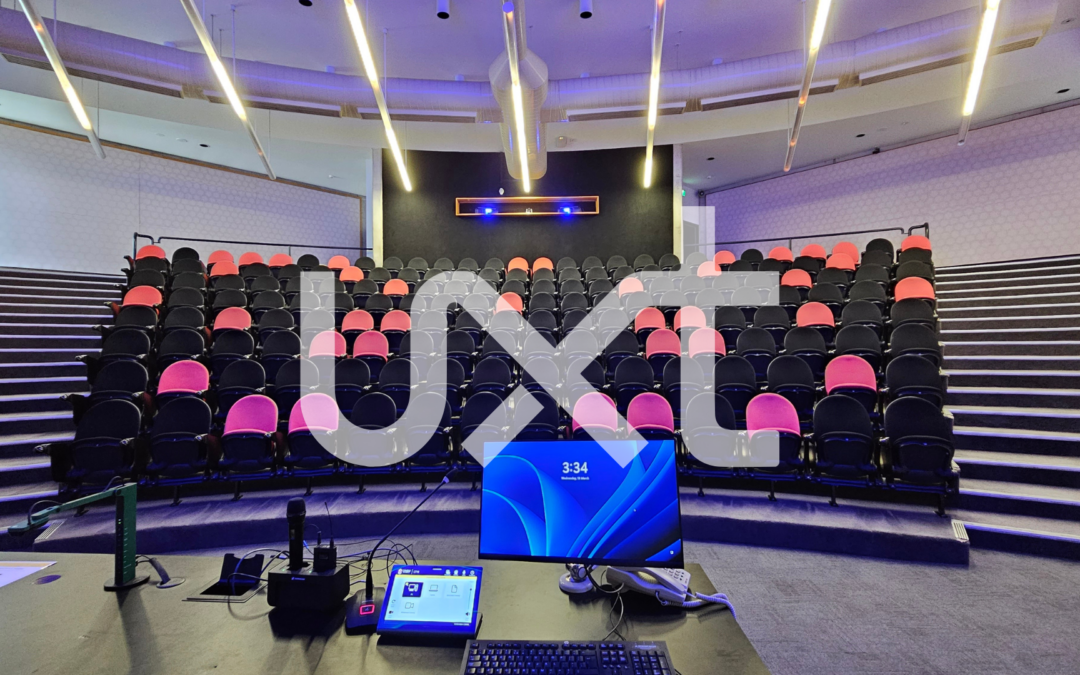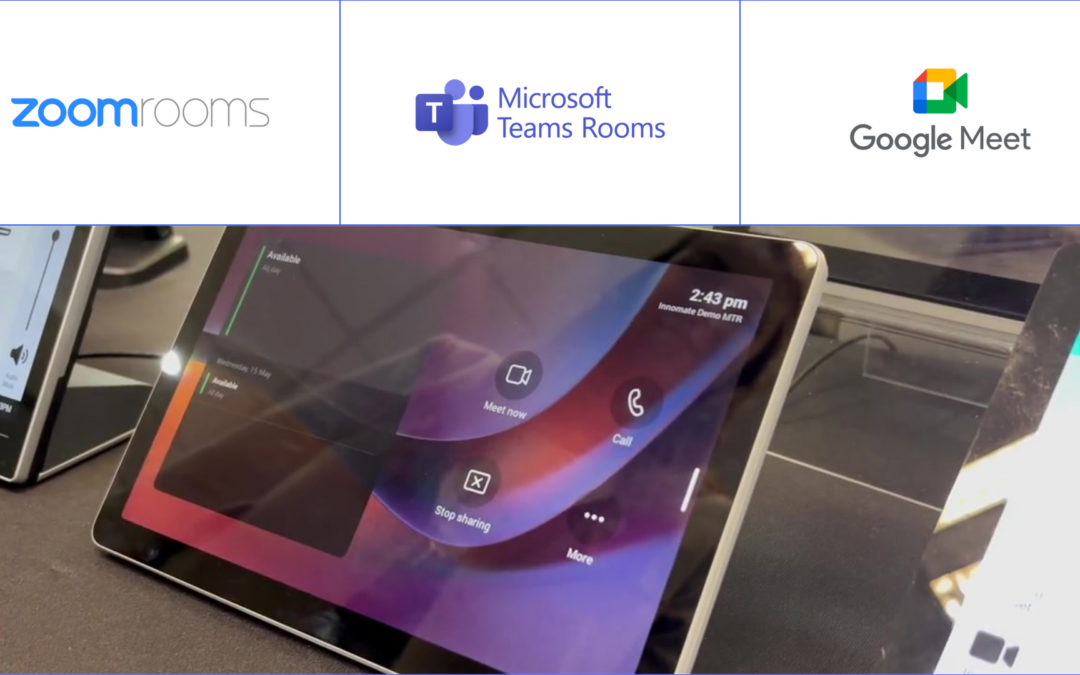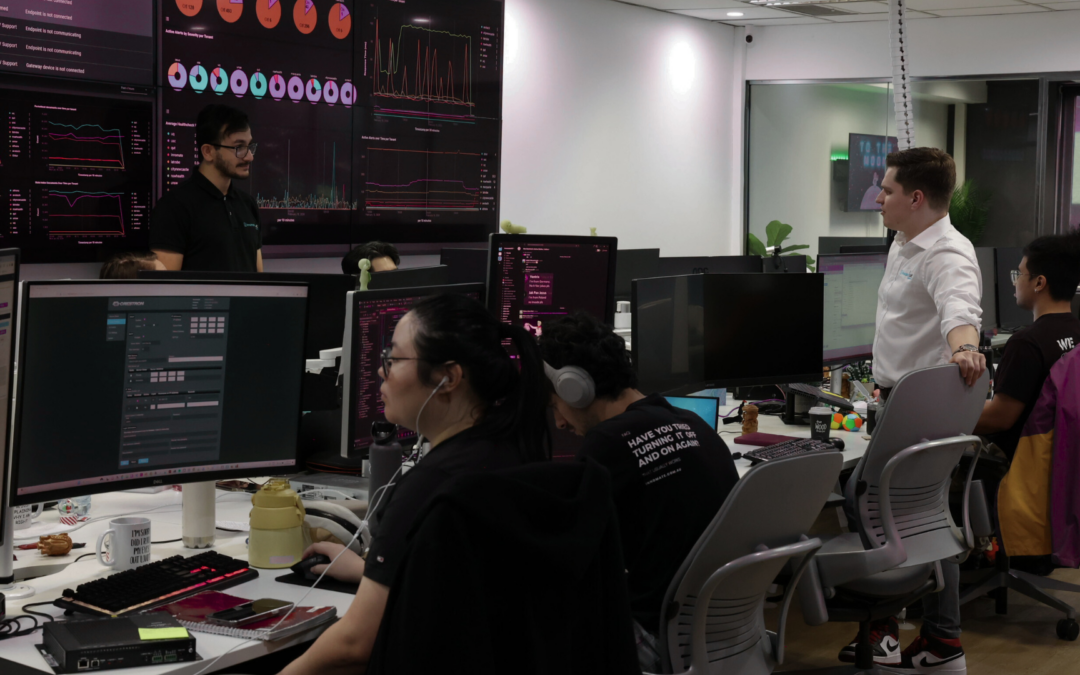AV Integration for Universities - Background
AV Integration for Universities has changed beyond recognition over the past decade. There was a time when “technology” in a learning environment meant that the room had an overhead projector.
Now, almost every classroom is equipped with smart boards, lecture mics, multiple audio sources, ceiling arrays, and all manner of mixed unified communications solutions.
This transformation in audiovisual (AV) technology has been nothing short of revolutionary – yet integrating AV into university environments remains overwhelmingly complex.
Today, universities are practically built on AV technology, and a learning space simply must work. What began as a fledgling industry only a few decades ago is now our primary window to the world, especially in education.
However, the rapid evolution of AV and UC technology and usage has led to a significant challenge: AV integration for universities can be complex and often difficult to manage. Hardware advancement has outpaced the software development that would usually tie complex systems together, but that hasn’t stopped the hardware from becoming vital.
“AV became essential before it became easy.”
Paul Yahcnhoucy, CEO of UXT.
UXT was founded nearly a decade ago specifically to address these challenges. Our business is dedicated to working with universities to enable them to bridge these tech gaps. Servicing the most prestigious universities in the country gives us an intimate insight into the challenges of modern higher education.
Here’s our guide to overcoming common obstacles in AV integration for universities – with a sneak peek into how our AV engineers solve these challenges on the ground daily.
1. Build AV solutions for compatibility and consolidation of data
Ensuring that your new AV technology operates seamlessly with existing systems can be a major stumbling block. IT systems have this figured out – networks can talk to each other with no problem. In AV, systems tend to work in isolation. Traditionally there’s been no easy way to make your Crestron panel be part of the same ecosystem as your Epson projector. Without the right software, these devices would be like oil and water; not exactly compatible.
The first step in the solution: Make AV solutions modular to solve compatibility problems
For compatibility issues, use modular solutions to help your AV devices speak to each other and allow for frictionless upgrades. UXT’s Chief Operating Officer, Jethro Fouadson, says the benefits of a modular system are that:
“It offers consistency, flexibility, reliability, cost efficiency, supportability, and goes a long way to helping with standardisation.”
A modular platform enables any university to integrate a range of technologies, software, and brands into a unified system.
Through extensive collaboration with our AV software partners, Innomate, we have established that an efficient university AV ecosystem should be designed to be modular, as should the underlying control component. With Innomesh, the room control application, in particular, is built to allow users to easily add and remove functionality and is tested and battle-hardened by its use across different organisations – all the while providing consistency of behaviour and user experience.
Whether you need to support a new projector model or migrate to AVoIP for video switching rather than a traditional video switcher, using a modular system means you can add and remove components yourself.
Using a modular AV system means:
- No more expensive service call-outs when you need a control code update to accommodate for your AV integration needs
- You have the building blocks for building your room standards that you know are supported in software
A modular system creates flexibility and supportability that you can rely on.
The importance of changing audiovisual hardware to be agnostic
Another solution for the compatibility of your AV environment is to ensure your platform is vendor-agnostic. This flexibility ensures that you can futureproof and leverage the best solutions in the market without being locked into a single vendor.
Tim Hinwood, former Manager for Learning Environment Design at QUT, says that flexibility through agnostic AV systems is one of the key steps that allow business units to navigate the AV landscape with confidence.
“Being able to pivot when product isn’t available, or technology changes is key to keeping our Learning and Teaching spaces operational and projects moving forward. This, in turn, allows us to maintain a continuity of service and experience in learning, teaching and meeting spaces for our students and academics alike.”
UXT’s COO, Jethro agrees:
“Being vendor-agnostic offers a wide range of benefits to the organisation. It means that they are able to take advantage of the best tech offered by a wide range of vendors, without having to be tied down to a specific vendor’s ecosystem. It also safeguards them from hardware stock shortages and other supply chain issues, by giving them the ability to pivot quickly, and providing them with more options when alternatives are needed.
When advising and supporting universities, we take a wholistic, future-proof approach, which is why we partner with Innomate. As a platform, Innomesh is foundationally built to be vendor-agnostic. It can integrate with a wide range of AV hardware and devices, and is even able to tap into the proprietary world by means of middleware solutions.
As seasoned AV software professionals, and alongside the Innomate team, we have the in-house expertise to develop on proprietary equipment from Crestron, AMX, Extron, Cisco, Q-SYS, etc. in order to open them up for integration into agnostic technologies. We then overlay these with a single pane of glass, empowering our university clients with the ability to manage and support these technologies all from one place.”
2. Navigating software limitations in AV
Software restrictions can limit the capabilities of AV integration for universities, especially when it comes to hardware. In our work in the higher education sector, we often find teaching space technologies need to evolve quickly alongside pedagogy – which means regularly integrating new tech.
However, the speed of change is limited by being tied to specific manufacturers. This makes teaching environments resistant to change, since they are often overly analog, fragmented, dispersed, and not future-proofed.
The AV integration solution: keep it customisable
Choose software that scales with your needs and regularly updates its features – look for evergreen SaaS that is highly tailorable to customer needs, and an integration partner that understands how critical this is.
This might look like:
- Decoupled user interfaces for customisation
- Tenant-specific UIs for adaptability
- Custom workflows and branding capabilities
- Ability to add custom system behaviour with low-code or no-code
This allows the adaptability needed to customise AV for your own unique requirements and allows maximum UX flexibility and customisation.
A Cisco Navigator (Room Kit) touch panel with a tailored UI with a page-flip to a Microsoft Teams Rooms UI (HTML5) powered by Innomesh
3. Reduce audio-visual complexity for users
Advanced AV setups require specialised skills for effective operation. IT teams are often tasked with implementing and updating audiovisual solutions but lack the specific knowledge to do it with ease.
Think electricians and plumbers – they’re in the same industry but have very different skill sets. A great electrician shouldn’t be expected to understand your plumbing.
The human side of AV: training, change management and organisational adoption
AV integration for universities doesn’t end after the deployment stage. While automating processes and creating user-friendly interfaces help make the technology more accessible, investing in staff training is one of the most effective and crucial ways to help reduce complexity. After all, complexity is relative, and dependent on knowledge.
Have your AV specialists run training with those that are interacting most with the technology. In universities, this will likely be your academics and your IT team.
At UXT, we have a tried-and-tested service for staff training, from AV teams to end-users, including every teacher on campus. This ensures academics have the foundational knowledge needed to use your AV equipment without interruptions.
When a university needs to scale training across the organisation, we provide the option to add Virtual Room training using augmented reality, with embedded video guides, audio overlays, and captions. Making your training self-serve goes a long way, and we have the testimonials to back this up.
“The best AV environments we see are ones where the support staff are well trained on how to take full advantage of the technology available to them, and have well established procedures on how to integrate platforms into their support workflows”, says Jethro.
“These are the environments that run the most smoothly on a day-to-day basis, make the best use of UXT support to address real issues beyond simple user errors, and drive innovation as they discover gaps in their workflows.”
“At UXT, we offer tailored training and support sessions to help our clients succeed. We recognise the importance of enabling our clients and that, as a business dedicated to university AV excellence, their success is our success, too.”
3. Make AV cost effective
High-quality enterprise AV solutions can require significant budgets. However, the real issue is often the lack of specialised AV knowledge. Without proper insight into the lifecycle and management of your devices, you’re likely to find yourself replacing equipment much sooner than necessary.
“There is a school of thought in the industry that if you want to rejuvenate an AV space, you need to rip out everything and start fresh.” Jethro says.
The UXT AV integration solution
However, starting fresh with your AV environment isn’t always cost-effective – and it’s not necessary.
“While it’s always nice to be able to have an impressive new fit out,” Jethro says, “there is a lot of value in rejuvenating and extending the lifetime of existing AV spaces. It gives you a better return on your investments, it’s better for the environment, and it allows you to increase the supportability of your entire AV room fleet more quickly.”
“At UXT, we believe in the importance of your entire AV environment being able to coexist and integrate with your existing technology, while also remaining adaptable and future-proof, so our service offerings are designed to do precisely that – adding a monitoring and support layer to existing AV systems without fundamentally changing how they work.”
Achieving cost-effectiveness is all about giving your old proprietary hardware a second life on new systems. Here at UXT, our engineering team is made up of seasoned AV professionals well-versed in the traditional arts of software development for platforms like AMX, Crestron, Cisco, QSC (Q-SYS), and Extron. Building and deploying middleware on these systems can open them up for modern integration and give them a new lease on life.
Use data to save costs on your AV
Instead of retiring your fleet according to the date marked on your warranty, analyse the lifecycle of every device based on usage statistics to find out whether a device actually needs replacing months in advance.
With advanced data analytics, you don’t need to retire your fleet; you can extend the lifecycle of your devices and elevate their capabilities to align with any new hardware joining the environment with a uniform user experience. It can extend the lifespan of your current AV fleet by years.
The cost-saving potential alone with data analytics is huge. If you have a projector used only 5% of the time, you can decide to sunset that device and not replace it.
Combining this tactic with a shift towards unlocking your hardware via a device-agnostic AV software platform will provide your university with even more direct cost savings, both short-term and long-term.
“The AV landscape is now a world of increased budgetary pressure, product shortages, shipping delays, and constantly moving goalposts,” says Tim Hinwood. “Meaningful data is the granular detail that informs us when, how and where AV devices are being used to drive informed decision-making.”
UXT makes AV integration efficient, fast, and low-risk
In a rapidly evolving sector, treating your university’s AV environment with the same principles as your IT ecosystem is the key to staying ahead of the curve.
Whether you’re an administrator, a faculty member, or a digital transformation evangelist, understanding these challenges and their solutions is your first step toward seamless AV integration. At UXT, we solve these challenges daily – we were born from them, and we’re dedicated to AV excellence for the higher education sector.
To find out how UXT can help your University to deploy a fully integrated, secure, highly available Audio Visual and Unified Communications solution, including ongoing support, get in touch with our team today for a free, no-obligation consultation.
More Articles




